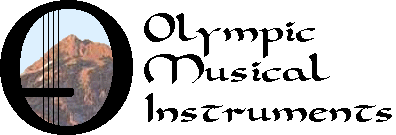






Frequently Asked Questions (FAQ)
Who are Olympic Musical Instruments?
OMI is made up of Alden and Cali Hackmann. We are the only workshop in
North America dedicated exclusively to building hurdy-gurdies. We have
been building them since 1988, when we began building a kit instrument
that inspired us to build a more advanced model. We presently have several
models available, and we offer repair and restoration services, as well
as a range of other products related to the hurdy-gurdy.
We are located on the Olympic Peninsula in Washington state, from which
we get our business name. Our town is Indianola, which is on the shore
of Puget Sound with a view of Seattle.
How did you get involved with the hurdy-gurdy?
It's a long story. The short version is that Cali saw one when she was in college and got fascinated with it. She bought a kit and we built it together, and it was terrible, but we were hooked. Before we had even finished the first instrument we were talking about the next one, a process that continues to this day. Ever since then we have been playing, designing, studying, building and restoring hurdy-gurdies.
We owe a great deal of our knowledge and enthusiasm about the instrument to RT Taylor, who in turn introduced us to our mentor and friend Pierre Imbert. Pierre helped us to establish the Over the Water Hurdy-Gurdy Festival, and while we had some knowledge of the instrument before, it was Pierre who taught us what the hurdy-gurdy is capable of and how to achieve it. To our great regret, we lost Pierre to a heart attack in 2001. We miss him very much, but we hear his voice every day in our work and our music.
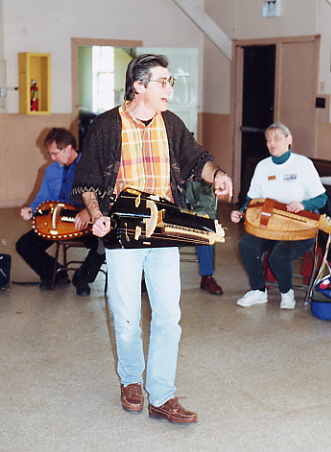
Pierre teaching a rhythm session at the 1999 OTW festival
What is a hurdy-gurdy, and how does it work?
The hurdy-gurdy is a stringed instrument in which the strings are rubbed
by a rosined wheel instead of a bow. The wheel is turned by the player's
right hand, while the left hand plays the tune on the keys in the keybox.
Two of the strings (usually), called the chanters or melody strings, run
though the keybox and their vibrating length is shortened by the key pressing
against it. Several drone strings are outside the keybox, and thus sound
the same note all the time. For this reason the hurdy-gurdy sounds similar
to a bagpipe. A small movable bridge on one of the drones can be made
to vibrate rhythmically by cranking the wheel harder, and this buzzing
is used for a rhythmic accompanyment to the tune. A diagram of the parts
is shown below.
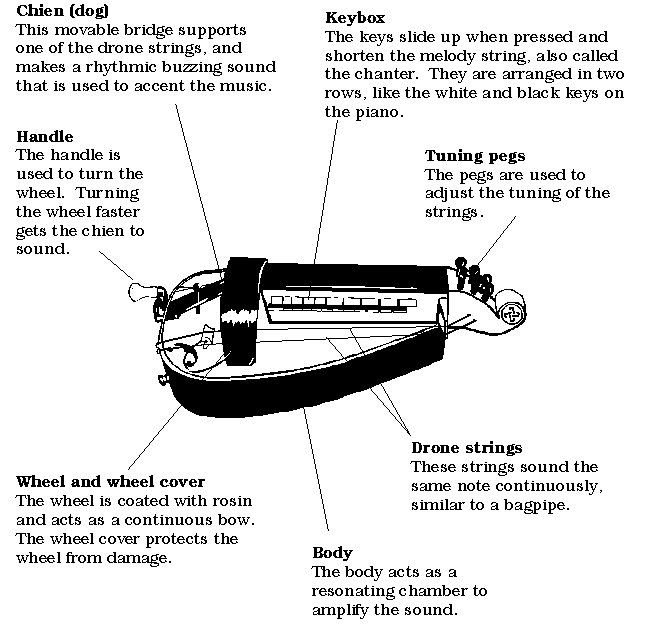
What does it sound like? Like a bagpipe?
It's different. Many people think that it's a wind instrument because it does sound somewhat like a bagpipe, because of the drone strings. It also sounds a little like a fiddle, because it's technically a bowed string instrument. The dog buzzing sounds a little like a rhythmic one-note kazoo. The whole gets wrapped together into a cross between a fiddle and a bagpipe, with someone keeping time on a kazoo.
Here's a short sample of two hurdy-gurdies on a Baroque duet: Baroque MP3 That's us, Cali and Alden. Cali is playing an Orca model, and Alden is playing the first Volksgurdy we built.
Here's a sample of one of our production models, the Chinook: Chinook sample. The first sounds are the strings being engaged on the wheel, after which Cali plays a Breton dance tune called "Kig Ha Farz", which is played for dancing an an dro. This instrument is tuned in D, but with the chanters an octave lower than is standard for a D/G tuning.
And here's a sample of our other production model, the Orca: Orca sample. At first the sound is just the strings being placed on the wheel in succession, then Cali plays a traditional bourée called "Bourée de Aurora Sand". The legend is that Frédéric Chopin wrote down the tune when he heard it played outside his window at Nohant, which was George Sand's country house.
The hurdy-gurdy often gets played with bagpipes, most often the musette
(in the 18th century when they were popular) and more recently the cabrette.
Contrary to Groves and the Robert Green book, the musette is not extinct,
but is still being made and played.
What is the history of the hurdy-gurdy?
Here's the short version: Hurdy-gurdies were fairly common though most of Europe from the 12th to the 19th centuries, and has been played by everyone from blind beggars to the nobility. The court of France developed an interest for it in the early 18th century, and their style of instrument has become the "standard" instrument, though strong hurdy-gurdy traditions remain in other European countries. The earliest instrument of this design was the organistrum, played by two people, as shown in stonework and pictorial references as early as the 12 century in northern France and northern Spain.
There's a lot more information on the history of the instrument. The
place to start looking is the bibliography.
Why is it called a hurdy-gurdy?
"Hurdy-gurdy" is the English name for the instrument. It's not clear when the name was first applied, or why it was called that. There's extensive discussion of this, especially in the Palmer and Bröcker books. The conclusion is that no one really knows. There's some speculation that "hurdy-gurdy" is related to the English word "hurly-burly", meaning a great noise.
Some players prefer to use the French name, vielle a roue, meaning
"wheel fiddle", possibly because of the association of the name "hurdy-gurdy"
with a barrel organ.
Isn't a hurdy-gurdy something played by a guy with
a monkey?
Yes and no. That instrument is a barrel piano or barrel organ, which
only plays preprogrammed tunes. It was played by turning a crank, so it
got named after the stringed instrument which preceded it. Though it is
techically sophisticated, it could be used by someone with no musical
talent, and was frequently used by street musicians who were more interested
in catching people's attention than in providing music.
Is there a hurdy-gurdy email mailing list?
Yes, of course there is. There's information about subscribing on the
HG List Page.
Certainly Donovan recorded a song called The Hurdy-gurdy Man. It's not clear whether he had the stringed instrument in mind when he wrote the song. Two minor pieces of evidence indicate that the song refers to the stringed hurdy-gurdy instead of the barrel organ. First, the lyrics refer to the hurdy-gurdy man "singing songs of love". The barrel organ can only play one or two songs, but the plural songs suggests that the instrument can play more than one. (Actually some versions of the barrel organ have interchangable discs or rolls which allow different tunes to be played, so this point is even more sketchy.) Second, Jimmy Page of Led Zeppelin reputedly played guitar on the studio recording (though no listing of musicians or instrumentation is given on the liner notes, and in some accounts he's quoted that he either didn't do it or doesn't remember doing it.) In any case it's documented that Page had an interest in the stringed hurdy-gurdy. There are unfounded rumors that a hurdy-gurdy appears on this album, and even on this song.
Pierre Imbert had a hurdy-gurdy signed by Donovan some 15 or 20 years after the recording, and it was the first hurdy-gurdy that Donovan had actually seen. He told Pierre that he had been walking on a beach in Hawaii and been visited by a vision of a man floating above the waves playing a hurdy-gurdy, and had written the first verse of the song. The other verses were a combined effort on the part of Donovan and George Harrison.
My personal theory is that Donovan used the word because he liked the alliterative quality of "hurdy-gurdy". In one verse he changes the refrain to "rolly-polly", which has the same quality, though I doubt that a song called "The Rolly-Polly Man" would have gotten quite as popular. Since he hadn't seen a hurdy-gurdy before, he probably just liked the way the word sounded.
The song has also been covered by several other bands, including the
Butthole Surfers. Donovan still plays it in concert.
Was that a hurdy-gurdy I saw at the Page/Plant concert?
Yes, it was. Jimmy Page and Robert Plant were joined on their 1995 World Tour by English hurdy-gurdy player Nigel Eaton, who also plays on 3 songs on the Unledded video. He plays several hurdy-gurdies, including a double-keyboard instrument made by his father, Chris Eaton, who is regarded as one of the best hurdy-gurdy builders in England. Nigel also appears on several other recordings, some of which are listed in the discography.
Some people believe that he has an electric hurdy-gurdy. The instrument he is playing is not actually an electric hurdy-gurdy, but rather an acoustic instrument with pickups on it, typically called an electro-acoustic hurdy-gurdy. (The guitar analogy is that he's playing the equivalent of a Martin D-28 with a piezo pickup under the bridge, as opposed to a Gibson Les Paul.) This particular instrument is unusual in that it has three rows of keys instead of the usual two. The third row of keys plays a tune on an extra chanter string, allowing him to play harmonies. (I haven't seen the instrument in person, but this is how it was described to me by someone who has. If you look carefully on the video, you can see the extra keys and tuning pegs.) It also has two dog bridges, which is a feature very rarely seen. The pickups on Nigel's instrument are briefly described by Emma Heape in the Hurdy-Gurdy Society Journal. Olympic Musical Instruments also makes electroacoustic instruments, like the one shown below. Denis Siorat also makes hurdy-gurdies with pickups and extra dogs, as does Bernard Kerboeuf.
Jimmy Page has had an interest in the hurdy-gurdy for a while. There's
a brief shot of him playing one in the Led Zeppelin concert film The
Song Remains the Same, though he's not holding it in the usual fashion,
and it doesn't sound very much like a hurdy-gurdy. The tune he is playing
is reputed to be called Autumn Lake.
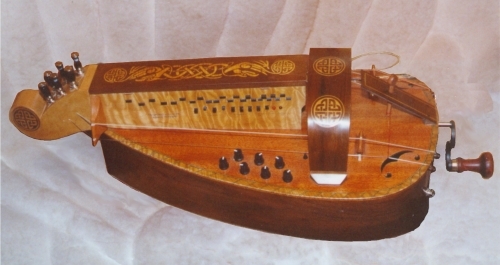
Electro-acoustic hurdy-gurdy built by Olympic Musical Instruments
Photo by Alden F.M. Hackmann
What kind of music is played the hurdy-gurdy, and
where can I find recordings of it?
A wide variety of types of music have been played and recorded on this
instrument. Some of these categories include medieval, renaissance, baroque,
and classical. Mozart, Chedeville and Bartok wrote pieces for the hurdy-gurdy.
The most common use of the hurdy-gurdy today is for early music and French
country dance music pieces, such as the bransle (pronounced "brawl"),
the bourree, the schottische, and the waltz, as well
as Breton dances such as the hanter dro,an dro and dans
plin. Another tradition that remains strong despite decades of supression
is that of Hungarian folk music. Some people are now using them in less
traditional settings, such as Irish music, other British Isles folk, and
offshoots from these traditions. Modern players are using them for jazz
and just about anything else you can think of.
Some recordings are listed in the discography.
We don't think so. Certainly there are levels to playing: it takes quite a while to get a good dog technique, or to play the more complex tunes. It's pretty easy to learn to play a simple tune. As with any instrument, it's easier to learn if you have an instructor to give you some pointers in the beginning, especially when learning the dog. It's certainly possible to learn from nothing more than a method book and extensive practice. It just takes longer to get it to sound good, and it's more likely that you'll develop bad habits that are difficult to change later. (An 8-year-old was playing tunes on our Minstrel Model in about half an hour.)
Certainly, if you have the skills and the patience. See the builder's
page for more information. It's a difficult task to build an instrument
that gives a good sound and plays well.
It looks really complex. Is it hard to maintain?
Some instruments are fussier than others, so it helps to have a good
quality instrument to start with. You do need to learn to change the cotton,
apply the rosin, and tune the strings and tangents. These can be frustrating
at first, but get to be much more automatic with practice. Some of these
operations are easier to learn from a person than from a book, especially
cottoning. We provide a video with our instruments that shows how to get
started (also available separately). The Destrem
and Heidemann book has a lot of useful advice about instrument maintenance.
Do the keys have springs on them?
The keys are usually returned to their resting position by gravity.
This means that the player needs to hold the instrument with the keybox
tilted down at least a little bit, which is the normal playing position
anyway. There is at least one European maker (Chris Eaton) who puts a
spring return on some keys, but this is a special feature not usually
found on a standard instrument.
Are there keyless versions of the instrument that
are even older?
The hurdy-gurdy and its precursor the organistrum have always had some
kind of keybox and keys to stop the strings. The stonework on the Santiago
de Compostela shows some of the earliest known evidence of an organistrum,
shown with one person cranking and the other manipulating the keys of
the keybox. (Rault's book is an excellent resource, showing all the iconographical
evidence.) This is one of the most amazing parts of the instrument's history:
it emerged quite suddenly with both the distinctive wheel and keybox features,
where one might expect that it would have evolved with either the wheel
or the keybox being added later.
There is a derivative instrument that has a crank and wheel for bowing
the strings and a fingerboard for stopping the strings, called the strohfiddle.
Praetorius has a picture of it, in the early 1600's. It's much less common
now than the hurdy-gurdy: I'm not aware that any examples survived.
Are there hurdy-gurdy organizations?
The main organization in North America is the Over
The Water Hurdy-Gurdy Association which sponsers an annual festival
in September, with instruction for all levels of play. There are other
organizations, listed in the Organizations Directory
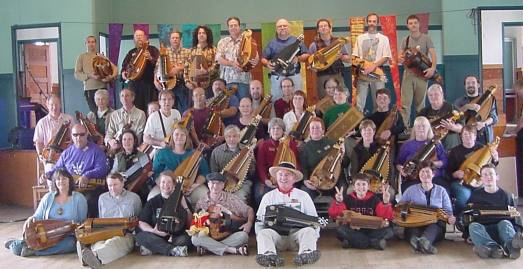
The group photo from the 2004 Over the Water Hurdy-Gurdy
Festival
For a larger file (113 MB) click
here.
Where can I find one, and how much do they cost?
There are several sources. You can order a new instrument from the U.S. (from us, for example - see our Frequently Asked Questions about ordering), a new instrument from Europe, or look for a used instrument. Makers and dealers are listed in the directory. Alternatively you can build one, but it's a substantial undertaking.
Good instruments from Europe are usually priced starting at about $4000. If you are interested in a European instrument, we can suggest some sources.
New instruments are made in the US and Canada by a few builders. If you intend to learn to play, be sure to select a maker with a good reputation. Because of the instrument's complexity, it's almost impossible to build a cheap hurdy-gurdy, or rather to build a good one cheaply. Make sure that the maker guarantees their work, and that the dealer is a reputable one to whom you can return the instrument if it doesn't function properly or can ask advice from. There are some dealers to be especially wary of, and it's always better to buy directly from the builder. Try to play the instrument before buying it (see How do I know if it's a good hurdy-gurdy?, below) Domestic instruments are generally less expensive than the imports.
Used instruments are available only occasionally. These can be anything from modern kit hurdy-gurdies to 200+ year old French instruments, and they have prices in a similar range. One place to look for these is the Used Instruments page. Be sure to play the instrument extensively before buying it, as used instruments can suffer from abuse, misuse, or neglect. If this is not possible, buy the instrument from a company that can provide a guarantee.
Here's a word of advice about the price of a hurdy-gurdy: it's an expensive instrument. If you really intend to play it, pay the money and buy a good one. It's really frustrating for the player to struggle with an instrument that doesn't work and is so poorly constructed that it can never work, and it's certainly frustrating for the experienced players, builders and repairers who have to look at the instrument and tell the player that they spent a lot of money on something that can't ever work. We know several people who have spent thousands of dollars on hurdy-gurdies which were inherently flawed and became "wall art".
What's up with the $20 hurdy-gurdy I found on the web?
Yes, indeed, there's a website that tells you how to make a hurdy-gurdy in a weekend for $20. We used to be polite to Dennis about this, but we gave it up after a while. Let's speak plainly: that's not a hurdy-gurdy, that's a Hurdy-Gurdy Shaped Object (HGSO). If you want an instrument that sounds like that, then that's your choice, of course. If you want an instrument that sounds like a hurdy-gurdy, you're going to have to invest much more than $20 and a weekend.
We're not in the business of building hurdy-gurdies for the money - if we were, we would be in some other business instead. We're here because we love the instrument. HGSO's do a great disservice to the hurdy-gurdy community: they give people the impression that this terrible sound is what a hurdy-gurdy is expected to sound like, and they waste the time and money of the builder/player. Caveat emptor.
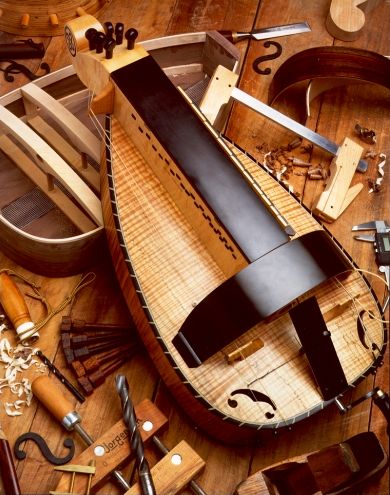
Volksgurdy - photo by Tim Crosby
How long does it take to make one?
It takes us somewhere between 200 and 300 hours to build the Volksgurdy model. While we use some modern machinery (including a computer-controlled laser cutter) to help us, there are many parts that need to be hand fitted to make an instrument that functions correctly. A local foundry makes the cranks for us, and we buy planetary tuning machines off the shelf. Almost all of the other parts in our shop, including the shafts and bearings for the wheel. There are about 225 parts in a Volksgurdy. For comparison, a guitar has about 60 parts. Cali calculated that over 4000 operations are needed to complete an instrument. It's a lot of work.
Are there places I can learn the hurdy-gurdy, or hear
it played?
There is an annual North American festival in September which is not
to be missed if you can help it:
the Over the Water festival. See above.
How do I know if it's a good hurdy-gurdy?
There is quite a range in the quality of instruments made by modern makers. The best thing to do is to find someone who is a good player who can test the instrument for you. The next best thing is to obtain a copy of Destrem and Heidemann's book on hurdy-gurdy adjustment and maintenance, which will help you familiarize yourself with the parts and features usually found on a quality instrument.
Very briefly, you want the wheel to turn smoothly and easily, with each string lying flat on the wheel. The wheel surface should be very smooth and free of skips, wobble, or bumps. (Don't touch the wheel surface to find out!) The shaft and wheel should have very little axial or lateral play, and the wheel should be removable. The wheel core should be of Baltic Birch, another laminated material, or a modern material which can resist changes in humidity. The keys should be freely moving without sticking but also without excessive play or rattle. The tuning pegs should hold securely and not wobble, and a tourne-a-gauche (tuning wrench) should be included if friction pegs are used. The dog should work, with the tirant changing its sensitivity.
Also see the section on sources and costs for
information about the inadvisability of buying a cheap instrument.
Why are they so expensive?
The short answer: because we know what we're doing, and we make excellent instruments.
Hurdy-gurdies take a long time to make, and they have a lot of moving parts. Our Volksgurdy model takes about 250 hours to make. The Minstrel Model takes about 80-100 hours, not including the time spent making jigs and fixtures. In comparison, a production model of a high quality steel string guitar takes about 16 hours or less to make (see the interview and factory tour with Bob Taylor of Taylor Guitars in Guitarmaker). Our materials cost is somewhat higher, since we need to stock more types of wood and can't buy in large volumes. We also need a wider variety of tools, since we use metalworking tools for the shaft, bearings, pegs, strap buttons, drone pins, and other parts. We've poured thousands and thousands of dollars into our tooling, and we still dream of getting better machines that would let us work more efficiently. We have a computer-controlled laser cutter, which we use for keys, keybox, and a number of other applications.
Other makers may use different techniques, but they face the same problems: literally hundreds of complex operations that can't be automated without setting up to make hundreds of instruments at a time, and the market is not large enough for that. Even with extensive tooling, most of the work on the instrument must be done by hand. After the instrument is completed, it needs to be played for a while to "work out the bugs" and get it ready to send to the customer.
If you find a hurdy-gurdy builder out there who is charging substantially less than we are, consider the reasons. They may be compromising on quality, or they just don't know how to build a good instrument. Do they support their product? Can you get the instrument back to them for service? Do they have a good track record?
In the lutherie industry, we have a saying: "It's not a profession, it's a lifestyle choice." If we had wanted to make money, we would have chosen just about any other career. We build and play because we love the instrument. (There's also that joke about the luthier who wins the lottery and just wants to build more instruments until the money runs out.)
Are there left-handed (backwards) hurdy-gurdies?
It's physically possible to make one. The real question is why one is needed. The left hand is used to play the melody, while the right is used to turn the crank and sound the dog. Both of these are complex motions, so there is no advantage to having a reversed instrument. If anything, a player who doesn't use the dog would probably prefer to be left-handed, playing a traditional right-handed instrument.
To make one left-handed, we'd need to thread the shaft, handle, wheel
and handle shaft backwards, with left-handed threads. There's no reason
not to do this, except that we don't have the taps and dies, the handle
shaft would have to be custom made instead of off the shelf, and the wheel
would need to be turned backwards, making for some unusual machine setups.
Setup of the instrument would prove problematic also, since we would need
to play the instrument to adjust everything and play it in, and neither
of us plays left-handed. It would be like starting playing all over again,
with a hurdy-gurdy that we didn't have working yet. We would be extremely
reluctant to make a reversed instrument, and we usually enjoy solving
technical challenges. We'd need a really convincing reason to make one.
There's a young player in France who has one, made for him because he's
missing some fingertips on his left hand, which definitely qualifies.
If anyone in this situation ever orders one, we'll figure out how to do
it.
What does Beati illi qui in circulum circumeunt,
fient enim magnae rotae mean?
It is translated as Blessed are those who go around in circles, for
they shall become big wheels. Cali heard this in a sermon when she
was in junior high school. We assume that the pastor, Wilbur Antisdale,
didn't have the hurdy-gurdy in mind when he said it.
Can I fly in an airplane safely with my hurdy-gurdy?
In a word, yes. There are some horror stories around, to be sure, but with due care and caution it can be done without trauma to you or the instrument. For more information, please read our guide Flying with your Hurdy-Gurdy
What tunings are available or common for the hurdy-gurdy?
Almost all of the HG's we build are tuned in G/C tuning, also called Auvernait because of its popularity in the Auvergne region in the center of France. This is the most common tuning used in North America. G/C tuning has the chanter or chanters tuned to g', which gives a C scale on the bottom row of keys, just like a piano. The trompette may be tuned to c' or more recently to g', the mouche is g, the petit bourdon is c, and the gros bourdon is G.Another popular tuning is D/G, called Bourbonnais or Berrichon because of its use in the Berry region which is to the east of the the Auvergne. The chanters are tuned in octaves, to a high d" and a low d'. This tuning gives a G scale on the bottom row of keys. The trompette is tuned to d', the mouche is g, the petit bourdon is d, and the gros bourdon is G.
Other tunings are available simply by choosing the right strings so
that the tension is correct. Trying to tune the chanter strings up a whole
note can cause the strings to break because of the tension, or at the
very least they'll sound pretty scratchy because of the increased string
pressure on the wheel. Drone strings are lower tension and have a bit
more leeway, but it takes quite a while (several days) for them to adjust
to their new tuning. Some players use a drone "capo" to change the tuning
of the drones, and there is an instrument feature called the
How do I know if my strings need to be changed?
After you’ve had your hurdy-gurdy for a while, you may notice that it is harder to keep in tune, just when you expect that it should beThe strings on a hurdy-gurdy are made of gut, thin strips of sheep intestine which are stretched, wound, dried, and polished to a particular diameter. Some strings are oiled, giving them a translucent appearance, and (unfortunately) a substantially shorter shelf life. We sell Savarez strings.
Gut strings are traditional for the hurdy-gurdy, although they are subject to changes in humidity and temperature. We have tried several substitute materials, including a synthetic material which has the same density, but we have yet to find a non-gut string that gives the right sound.
Over time, even the best gut strings degrade and get "mushy" and hard to tune. Some people change their strings every month. The average player should change the chanter and trompette strings at least every six months. The larger strings last longer - several years at least for the wound bourdons (which is as well because they're more expensive.)
While it may seem a daunting task at first, with a little practice and the right tools changing your strings becomes relatively easy. A pair of hemostats or long tweezers are very helpful. Be careful to keep the chanter nuts aligned in their proper direction, and turn the peg or tuning machine in the proper direction (which will require more thought than usual, because you'll likely have it sitting upside down.). We like to put a little clockwise spiral pencil mark inside the peghead so that we can see which way the peg should be turning. If the string winding doesn't match the spiral, it's going the wrong way.
How do you mic a hurdy-gurdy in the recording studio?
The first problem to be overcome is that because there are so few of these instruments around, most recording engineers have never even seen one, and they need to be educated about the need to balance the sound of the drones, the chanters, and the trompette. Frédéric Salter, engineer for Ad Vielle Que Pourra, had the following suggestions:The problem is that, in order to have all the warmth from the "bourdon", it is necessary to have the mike up close. Unfortunately, in doing so, depending on the piece, the "chien" will suddenly jump out at you, or the "chanterelle". The answer is to have a large diaphragm condensor mike, a warm sounding one such as a vintage Neumann u67, u47, or a TLM170, about 4 or 5 feet away, (of course, good acoustics are important), to get maximum warmth, in order not to over-equalize, something I had to do every time. Move the mike around to get the best balance between the 3 elements, and keep in mind you will still have to equalize to dull or sharpen the "chien" (around 6k to 10k) and to bring the "chanterelle" in or out(around 600hz to 1k). I am sure you realize also that some instruments, no matter what you do, will never sound the way you want them to. It [the hurdy-gurdy] is a strange but fascinating animal.
In our own recording experience with the hurdy-gurdy, we've found several mics and techniques which have given good results.
- Start with a room that the instrument sounds good in, remembering that the sound that you (the player) hear is not the same as the sound that a listener in front hears. Trust your producer when they tell you that it sounds good in a particular room or position.
- Record in stereo if possible. A good stereo pair will give a more natural sound.
- Some mics we've used to good effect: AKG C-414's as spaced pair omnis, Earthworks QTC40's as a spaced pair (previously the QTC1), and our favorites, a Blumlein pair of Royer R122 ribbon mics about 4 feet away.
If you have other suggestions or a different experience with recording the hurdy-gurdy, please let us know.
What are the differences between the French, Hungarian, and other styles of hurdy-gurdy?
There are many styles of hurdy-gurdy, but French is the most common. Most of the ones we make are French style, with some variation in decoration, so they're domestic, but also essentially French. The main features that are commonly French: two chanters, four drones, French style trompette (more on that in a moment), 23 keys in two rows, upper keyfronts form a solid line, key shafts extend through the back of the keybox so you can tell which key you're pressing, keybox and peghead taller than their width, chanter strings and trompette tuned fairly high.The same features on a Hungarian instrument, which is called a tekerö or tekerölant, meaning "rotary lute": one chanter, two drones, Hungarian style trompette (see below), keys still in rows, but not quite as many, upper keyfronts form a broken line, keybox is so wide that key shafts don't extend through the back, peghead also quite wide, chanter and trompette tuned much lower.
The older symphonie style can vary quite a bit: one or two chanters, up to four drones, may or may not have a French style trompette, may be chromatic or diatonic, key shafts don't stick out the back, peghead may be internal or external, but is almost always very wide, chanters may be tuned high or low.
The trompette: This is the buzzing bridge that only buzzes when you crank the wheel harder, used for rhythmic accompaniment. The principle is the same for both French and Hungarian styles: the faster movement of the wheel lifts the bridge off the soundboard for an instant, and the string pressure pulls it back down, and it taps the soundboard. This process is repeated so fast that the bridge makes a buzzing sound.
The French bridge is called the chien or dog, and rather looks like one. Its sensitivity is regulated by the pressure of a thread (called the tirant) which is wound around a friction peg through the tailpiece. More tension on the tirant increases the dog's tendency to buzz. The Hungarian dog system is a bit different: the dog doesn't always rest on the soundboard, and the regulation is achieved with a wedge of wood which pushes the string down. Pushing the wedge farther in will increase the tendency to buzz. The French dog sound tends to be more piercing and (I believe) can be crisper. The Hungarian trompette is tuned lower and is also more raspy, with a slower, heavier and often louder buzz.
I have a hurdy-gurdy from Musicmaker's, and it doesn't sound very good. What can I do?
This information also applies to the Hughes Dulcimer instruments, which are similar to the Musicmaker's, but are usually worse. There are several steps you can take to improve the quality of the sound from this instrument, but there's a limit to how much can be done for it. The first place to start is to get the Destrem and Heidemann's book, or our DVD on hurdy-gurdy maintenance. D&H is an invaluable resource.Musicmaker's supplies the instrument with nylon strings. Our observation is that the gut gives a better sound, and it's easier to apply the cotton. We sell a set of strings to tune the instrument in C (G chanters, G and C drones) but we can also provide other string sets if you have a different tuning that you prefer. Frequently the strings will need to be shimmed out from the wheel. Shimming is discussed at length in the Destrem and Heidemann book.
Another frequent problem with this instrument is the chanter bridge. Sometimes it's glued on the wrong place: the distance from the side closer to the wheel to the center of the tangent of the octave key (the seventh key from the head) should be equal to the distance from the center of that tangent to where the string enters the peghead. This assumes that the key spacing is correct, which it isn't always - in which case you'll have to optimize the bridge position to reduce the errors as best you can. The key spacing should follow the rules for fret spacing which are covered by many guitar design books. (For one repair, we used a spreadsheet to compare the predicted key positions with the actual ones, plugging in various scale lengths until one was found that minimized the errors.) If the bridge is out of place by more than 2 mm (1/8"), you should remove the bridge and glue it back down in the proper place.
Another problem is that when it's glued on in the right place, it's still not supported. The pressure of the strings is in two directions: down toward the soundboard, and sideways toward the wheel. Even though the downward force is greater than the sideways force, the bridge is being slowly pushed toward the wheel. Over time the thin top of the bridge will bend, and eventually it will either break or the glue joint will fail.
To prevent this from happening, we suggest adding a support to stop the bridge from bending toward the wheel. This can be done without removing the bridge. The best solution we have found is a violin tailpiece adjuster, available from a violin shop or from us. Wittner and Sacconi brands work well, for example.
Remove the little adjusting nuts and set them aside for later use. You will need a drill with a bit that drills a hole just large enough to fit the adjuster. Drill an angled hole pointing toward the top of the bridge in the center of the tailpiece (the block that extends above the soundboard and holds the ends of the strings). Use an awl to mark the starting point of another hole near the top of the bridge, in the center. Drill this hole pointing toward the tailpiece, being careful to avoid hitting the wheel with the drill. Place the tailpiece adjuster through both holes and cut it so that it extends about 1/4" on either side. Heat the cut end (not the threaded end) with a blowtorch or lighter until it is soft, then crush it with a pair of pliers to widen it. Repeat this process until the end is too large to fit through the hole. Place the adjuster through the tailpiece and the bridge, and put on one of the little nuts. Tighten it until it just touches and holds the bridge. Once it's in place, you don't need to adjust it again.
I didn't find the answer I was looking for. Now what?
First, look through the information on our Reference Pages. If it's not there, please contact us.
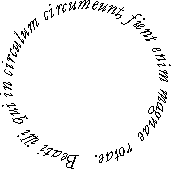
Please contact us if you have comments or questions about this page or other pages on this site.
Alden and Cali Hackmann
Olympic Musical Instruments
Beati illi qui in circulum circumeunt, fient enim magnae rotae.
© Copyright 2000, 2005, Olympic Musical Instruments.
Please ask for permission to use material from this site. Thank you.